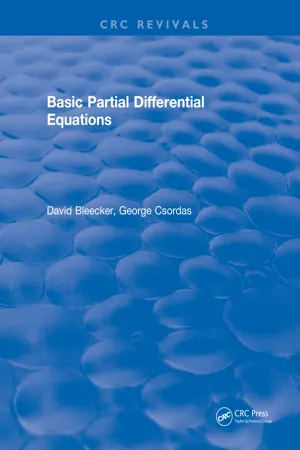
- 765 pages
- English
- ePUB (mobile friendly)
- Available on iOS & Android
eBook - ePub
Basic Partial Differential Equations
About this book
Methods of solution for partial differential equations (PDEs) used in mathematics, science, and engineering are clarified in this self-contained source. The reader will learn how to use PDEs to predict system behaviour from an initial state of the system and from external influences, and enhance the success of endeavours involving reasonably smooth, predictable changes of measurable quantities. This text enables the reader to not only find solutions of many PDEs, but also to interpret and use these solutions. It offers 6000 exercises ranging from routine to challenging. The palatable, motivated proofs enhance understanding and retention of the material. Topics not usually found in books at this level include but examined in this text:
The text requires some knowledge of calculus but none on differential equations or linear algebra.
Frequently asked questions
Yes, you can cancel anytime from the Subscription tab in your account settings on the Perlego website. Your subscription will stay active until the end of your current billing period. Learn how to cancel your subscription.
At the moment all of our mobile-responsive ePub books are available to download via the app. Most of our PDFs are also available to download and we're working on making the final remaining ones downloadable now. Learn more here.
Perlego offers two plans: Essential and Complete
- Essential is ideal for learners and professionals who enjoy exploring a wide range of subjects. Access the Essential Library with 800,000+ trusted titles and best-sellers across business, personal growth, and the humanities. Includes unlimited reading time and Standard Read Aloud voice.
- Complete: Perfect for advanced learners and researchers needing full, unrestricted access. Unlock 1.4M+ books across hundreds of subjects, including academic and specialized titles. The Complete Plan also includes advanced features like Premium Read Aloud and Research Assistant.
We are an online textbook subscription service, where you can get access to an entire online library for less than the price of a single book per month. With over 1 million books across 1000+ topics, we’ve got you covered! Learn more here.
Look out for the read-aloud symbol on your next book to see if you can listen to it. The read-aloud tool reads text aloud for you, highlighting the text as it is being read. You can pause it, speed it up and slow it down. Learn more here.
Yes! You can use the Perlego app on both iOS or Android devices to read anytime, anywhere — even offline. Perfect for commutes or when you’re on the go.
Please note we cannot support devices running on iOS 13 and Android 7 or earlier. Learn more about using the app.
Please note we cannot support devices running on iOS 13 and Android 7 or earlier. Learn more about using the app.
Yes, you can access Basic Partial Differential Equations by David. Bleecker in PDF and/or ePUB format, as well as other popular books in Mathematics & Differential Equations. We have over one million books available in our catalogue for you to explore.
Information
Table of contents
- Cover
- Half Title
- Title Page
- Copyrigt Page
- Table of Contents
- Preface
- 1. Review and Introduction
- 2. First-Order PDEs
- 3. The Heat Equation
- 4. Fourier Series and Sturm—Liouville Theory
- 5. The Wave Equation
- 6. Laplace’s Equation
- 7. Fourier Transforms
- 8. Numerical Solutions. An Introduction.
- 9. PDEs in Higher Dimensions
- Appendix
- References
- Selected Answers
- Index of Notation
- Index